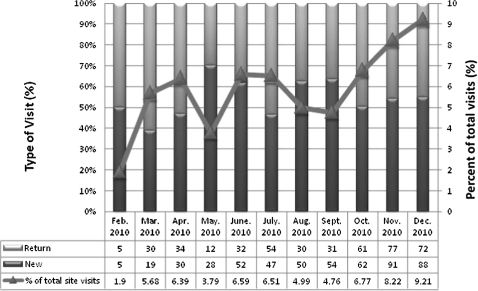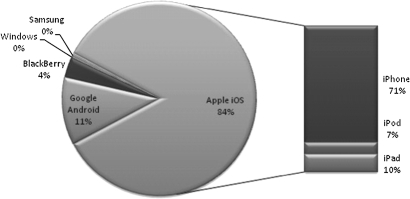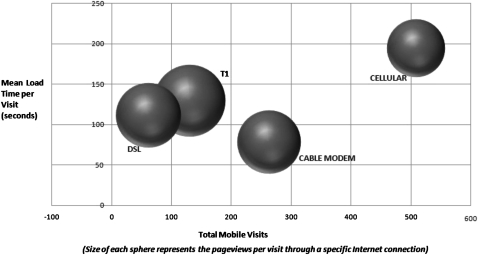Abstract
Healthcare providers (HCPs) use online medical information for self-directed learning and patient care. Recently, the mobile internet has emerged as a new platform for accessing medical information as it allows mobile devices to access online information in a manner compatible with their restricted storage. We investigated mobile internet usage parameters to direct the future development of mobile internet teaching websites. Nephrology On-Demand Mobile (NODM) (http://www.nephrologyondemand.org) was made accessible to all mobile devices. From February 1 to December 31, 2010, HCP use of NODM was tracked using code inserted into the root files. Nephrology On-Demand received 15 258 visits, of which approximately 10% were made to NODM, with the majority coming from the USA. Most access to NODM was through the Apple iOS family of devices and cellular connections were the most frequently used. These findings provide a basis for the future development of mobile nephrology and medical teaching tools.
Keywords: Healthcare, internet, mobile, nephrology, education
Introduction
In the last decade, an increasing number of healthcare providers (HCPs) have been using online medical information for self-directed learning and patient care. In some studies, sites such as UpToDate have been demonstrated to improve medical knowledge.1 Moreover, the ASN Learning Center and HDCN have continued to expand the number of online nephrology medical resources for HCPs.2 3 In recent years, the mobile internet has emerged as a new platform for accessing medical information.4 The mobile internet allows hand-held (mobile) devices to access online information in a manner that is compatible with their restricted computing power, small screen size, and limited hard drive space.4 HCPs are increasingly using mobile devices to access the mobile internet for textual- and multimedia-based medical information at the point-of-care. However, the design of mobile internet teaching websites is very challenging. Many full version (or desktop) websites are incompatible with the mobile internet platform.4 Established nephrology medical websites have not investigated the mobile internet to determine how best to create mobile teaching tools. In our descriptive study, we investigate the fundamental parameters of mobile internet usage of one nephrology site to direct the future development of mobile internet teaching websites.
Methods
Nephrology-related information was made available through Nephrology On-Demand (NOD) (http://www.nephrologyondemand.org) (ISSN 2155-9813). This is a desktop version website programmed and maintained by the lead author (TD). A mobile-specific version of the website, known as Nephrology On-Demand Mobile (NODM) was accessible to all mobile devices (smart phones, PDAs). The same URL could be used to access NOD and NODM. Computer code, included in the root files of the website, automatically displayed NODM when accessed through a mobile device. Both versions provided the same teaching content, search functionalities, and commenting capabilities. Teaching material was available in the form of slide presentations, video (with and without synchronized audio), audio only, and text. Hyperlinked citations were provided for all teaching materials. Teaching resources were open to all HCPs. Users were made aware of the existence of a mobile version on the homepage of the full website.
Google Analytics code was inserted into the root files of the website. This code tracked various dimensions for all mobile devices. Data were collected from February 1 to December 31, 2010. Means, standard deviations, and Pearson product coefficients were calculated using Microsoft Excel 2007 and verified for accuracy by the Division of Biostatistics at East Carolina University.
Results
The types of HCPs accessing the website are shown in table 1. The largest group of non-physicians accessing NOD were registered nurses or registered dieticians at 11%. A total of 966 visits (mean±SD 88±48 visits per month) were made to NODM out of a total of 15 258 visits (1387±476 visits per month) to NOD. Approximately 6% of all visits (5.93±1.95% visits per month) to the full website were through a mobile device (figure 1). Both new and return visitors used mobile devices with similar frequency (48±27 vs 40±23 monthly mobile visits, respectively). In total, 93% of visits were from the Americas, with 89% from North America, 85% from the USA, and 21% from our institution.
Table 1.
Provider type accessing NOD (n=465 self-reported visits)
| Faculty in nephrology (adult or pediatric) | 15% |
| Fellow in nephrology (adult or pediatric) | 17% |
| Resident in internal medicine or pediatrics | 9% |
| Faculty in internal medicine | 1% |
| Private practitioners (MDs) in nephrology | 12% |
| Private practitioners (MDs) in internal medicine | 2% |
| Non-MDs (students, nurses, dieticians, pharmacists, pharmaceutical representatives, patients) | 37% |
| None of the above | 7% |
Figure 1.
Percentage of mobile visits and proportion of new versus return visits to the mobile website.
Six different mobile operating systems were used to access NODM. Worldwide, 83.6±5.9% of monthly visits were through Apple iOS devices, with 75% from North America (figure 2). Mobile devices using the Google Android operating system were a distant second at 10.4±4.8% worldwide, with 10% from North America. Windows-based mobile devices contributed a total of two visits (<1%). Nokia devices, which are the most popular worldwide, were not used to access the website during the study period (table 2).
Figure 2.
Mobile device usage of NOD based on operating system.
Table 2.
Worldwide market share and worldwide and NODM internet usage
Irrespective of the mobile device used, access to NODM occurred most frequently through cellular connections (51.1±13.1% of monthly mobile visits). Connections via cable modems occurred in 26.2±5.7% of cases and T1 connections, the fastest connections monitored, accounted for 15.3±11.4% of monthly mobile visits. Cellular connections also had the longest load times and the least page views per visit (figure 3). Both DSL and T1 connections produced the lowest number of visits, but resulted in the most page views per visit.
Figure 3.
Mobile internet connectivity types by usage and speed.
Discussion
There are two important findings from this investigation. First, the mobile internet is infrequently used to access NODM. Second, and more importantly, HCPs use the mobile internet in significantly differently ways from the overall population of mobile internet users.
We provided a mobile-specific version of NOD to be accessed through mobile devices. The mobile version resulted in 88 mobile visits/month, which is consistent with previously reported findings. Leon et al and Hauser et al reported 86 and 52 mobile visits/month to online medical learning sites, respectively.5 6 Considering that the number of internet-capable mobile devices is projected to increase to 20% of all mobile devices by 2013, and that physicians are increasingly satisfied using mobile devices to access medical information, it was surprising that access to the mobile website was never more than 10% of all monthly visits to the full website.6–9 Given the increasing popularity of these devices, the limited number of mobile visits suggests that healthcare visitors are unaccustomed to, unaware of, and/or do not prefer online learning through mobile devices.
Online visitors to NODM used the mobile internet in strikingly different ways compared to the general population of mobile internet users. Overall, 85% of NODM visits came from the USA, with only 5% coming from Asia. In contrast, data from the general population show that only 40.3% of mobile internet visits are from the USA.10 Mobile internet users from Asia accounted for 31% of all general mobile visits, six times more than the percentage of visits from Asia to our website. It is unclear if the disproportionately large number of domestic users was due to the website being developed and hosted by a US-based academic nephrology group. It may also be that Asian users predominantly access Asia-hosted websites. Nevertheless, it appears that to develop a successful mobile teaching website, nephrologists should provide teaching material relevant to their domestic, rather than global, audience.
HCPs who accessed the mobile website overwhelmingly used Apple iOS devices. Previous studies have indicated that as many as 60% of HCPs prefer to use Apple mobile devices to access the mobile internet.7 11 However, only 54% of mobile devices in North America are Apple iOS.10 Google Android devices, which comprise 26% of worldwide and 33% of North American mobile devices, contributed approximately 10% of NODM visits. Because HCPs predominantly use Apple iOS devices, medical educators should avoid using Adobe Flash, a commonly used multimedia format that is not Apple iOS compatible, if they wish to reach the greatest number of HCPs.
Finally, most HCPs accessed the mobile website through a cellular connection, which meant they also spent the greatest amount of time loading the least number of teaching web pages per visit. A T1 or cable modem connection meant visitors spent less time loading content and so were able to view more teaching web pages per visit. These findings illustrate a trend. The majority of learners accessed the mobile internet through a cellular connection, whose data transfer speed limited the number of teaching web pages that could be seen at any one visit. This trend also suggests that HCPs may not have access to faster mobile internet connections.6 The increasing availability of high-speed internet may not be reaching a large portion of HCPs who used NODM. As a result, medical educators should program teaching content in ways that allow for fast loading through cellular connections. To do otherwise would limit the number of mobile users who could access teaching content or result in incomplete teaching.
A number of study limitations deserve mention. First, we were unable to compare our data with those for other nephrology websites. Popular online medical/nephrology resources, such as UpToDate, ASN Learning Center, or HDCN, have not investigated mobile internet usage of their respective sites.1–3 Second, our database did not directly measure user satisfaction with the mobile website or access by connection speed. Given the small screen sizes of mobile devices, a satisfaction survey was not feasible. As a result, it is possible that the numbers of visits, geographic and/or technical data are skewed because of unmeasured dissatisfaction with the mobile website. Slower connection speeds may have increased user dissatisfaction and resulted in fewer visits.12 However, previous reports have indicated that as many as 77% of physicians found using mobile devices helpful.13 Third, we could not determine the number and usage of each mobile device by country of origin. This factor limited our ability to explore the mobile internet usage patterns of US-based HCPs, who comprised the greatest proportion of mobile learners. Fourth, we cannot comment on how specific HCPs use mobile devices to access the web, although studies indicate that use of mobile devices to access medical information has increased in nearly every HCP subgroup since 1999.14 Finally, our understanding of learning through mobile devices may be outdated because of the rapid evolution of mobile education and technology.
Conclusion
Given the increasing number of mobile devices, nephrologists, medical educators, and established medical website developers will find challenging to develop relevant, accessible, and user-friendly mobile teaching tools. This challenge is compounded by the fact that medical education through the mobile internet is an under-studied area that is rapidly evolving. Established websites have shown success in educating HCPs, but have not been able to recreate such successes on the mobile internet platform. Although descriptive in nature, our investigation can play a positive role in this area as it demonstrates how HCPs use the mobile internet to obtain information. These findings can guide the future development of mobile internet teaching tools. Additional studies will be necessary to assess the effectiveness of mobile devices and mobile-specific websites.
Acknowledgments
Suzanne Hudson of the ECU Biostatistics department is thanked for her help in calculating and validating our statistical analyses.
Footnotes
Competing interests: None.
Provenance and peer review: Not commissioned; externally peer reviewed.
References
- 1.Research about UpToDate. http://www.uptodate.com/home/institutions/research.html (accessed 22 Feb 2011).
- 2.ASN Learning Center. http://www.asn-online.org/education_and_meetings/distancelearning/learning-center.aspx (accessed 22 Feb 2011).
- 3.HDCN http://www.hdcn.com (accessed 22 Feb 2011).
- 4.Hu WC, Yeh JH, Chu HJ, et al. Internet-enabled mobile handheld devices for mobile commerce. Contemp Manag Res 2005;1:13–34 [Google Scholar]
- 5.Hauser SE, Demner-Fushman D, Jacobs JL, et al. Using wireless handheld computers to seek information at the point of care: an evaluation by clinicians. J Am Med Inform Assoc 2007;14:807–15 [DOI] [PMC free article] [PubMed] [Google Scholar]
- 6.Leon SA, Fontelo P, Green L, et al. Evidence-based medicine among internal medicine residents in a community hospital program using smart phones. BMC Med Inform Decis Mak 2007;7:1–11 [DOI] [PMC free article] [PubMed] [Google Scholar]
- 7.Busis N. Mobile phones to improve the practice of neurology. Neurol Clin 2010;28:395–410 [DOI] [PubMed] [Google Scholar]
- 8.Shiffman RN, Liaw D, Navedo DD, et al. User satisfaction and frustration with a handheld pen-based guideline implementation system for asthma. Proc AMIA Symp 1999:940–4 [PMC free article] [PubMed] [Google Scholar]
- 9.Martin S. More than half of MDs under age 3 now using PDAs. CMAJ 2002;167:952. [PMC free article] [PubMed] [Google Scholar]
- 10.AdMob Mobile Metrics Report May 2010. http://metrics.admob.com/wp-content/uploads/2010/06/May-2010-AdMob-Mobile-Metrics-Highlights.pdf (accessed 3 Jan 2011).
- 11.Elmer-Dewitt P. Six Out of Ten Doctors Prefer iPhones. CNN Fortune; http://www.tech.fortune.cnn.com/2009/08/04/six-our-of-10-doctors-prefer-iphones (accessed 23 Jun 2010). [Google Scholar]
- 12.Chen ES, Mendonca EA, McKnight LK, et al. PalmCIS: a wireless handheld application for satisfying clinician information needs. J Am Med Inform Assoc 2004;11:19–28 [DOI] [PMC free article] [PubMed] [Google Scholar]
- 13.Phua J, Lim TK. How residents and interns utilise and perceive the personal digital assistant and UpToDate. BMC Med Educ 2008;8:39–47 [DOI] [PMC free article] [PubMed] [Google Scholar]
- 14.Garrity C, El Eman K. Who's using PDAs? Estimates of PDA use by healthcare providers: a systematic review of surveys. J Med Internet Res 2006;8:e7. [DOI] [PMC free article] [PubMed] [Google Scholar]





